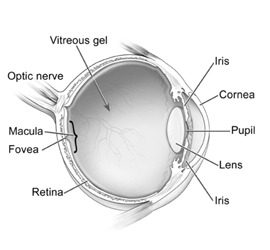About the Different Types of Cataracts
A cataract is a clouding of the lens in the eye that affects vision. Most cataracts are related to aging, and cataracts are very common in older people. By age 80, more than half of all Americans either have a cataract or have had cataract surgery, according to government studies.
It is important to know that cataracts can occur in either or both eyes. They cannot spread from one eye to the other.

There are three main types of cataracts. The most common nuclear cataracts involve diffuse cloudiness throughout the lens. A cortical cataract, located in the mid-periphery of the lens, is orientated similarly to the spokes in a wheel. A subcapsular cataract develops in the posterior outer layer of the lens, creating a “ground glass” appearance on slit lamp exam. The subcapsular cataract often causes more difficulty with reading and can be associated with glare symptoms.
What Are the Different Types of Cataracts?
There are several types of cataracts that may affect your vision. Each type of cataract can be developed differently based on what causes them. These cataract types include:
Nuclear Cataracts: These cataracts affect the center of the lens and can lead to the blurriness of far away objects, while objects up close will appear clearer. Over time, nuclear cataracts may cause your lens to turn yellow or brown, worsening your vision and sometimes making it difficult to tell colors apart.
Cortical Cataracts: These cataracts affect the edges of the lens, causing spots or streaks to appear on the outer edge of the lens. While the cataract grows, these spots or streaks can spread to the center of the lens, affecting how you see light.
Posterior Subcapsular Cataracts: These cataracts will affect the back of the lens, causing small spots to form in the path of light. Posterior subcapsular cataracts tend to grow faster than others and may reduce your vision in bright lights, causing you to see halos or glares.
Congenital Cataracts: These cataracts are the types of cataracts that you are born with or develop early on during your childhood. Congenital cataracts can be passed down from your parents or associated with an infection or trauma from the womb. Sometimes, these types of cataracts don’t affect your vision at all, but it’s always advised to get the condition of your cataracts professionally checked.
What Are Cataract Symptoms?
There are multiple vision changes and symptoms you may experience when you have cataracts. These symptoms can include:
- Cloudy vision
- Blurry vision
- Dim vision
- Sensitivity to light
- Difficulty seeing clearly at night
- The need for brighter lights to properly see
- Seeing glares, halos, spots, or streaks
- Frequent changes in your eyeglass and contact lens prescription
- Double vision in one eye
Who Do Cataracts Affect the Most?
Cataracts typically occur in patients aged 65 and older unless your cataracts were developed at birth or in early childhood. Despite these demographics, there are a number of risk factors that may increase your chance of developing cataracts. These risks include:
- Diabetes
- Prolonged sun exposure
- Smoking
- Genetic history of cataracts
- Eye injuries
- Eye inflammation
- Previous eye surgery
- Prolonged use of certain medicines
- Drinking alcohol
- Obesity
What Happens If I Leave My Cataract Symptoms Untreated?
Even while some cataracts may not cause any damage to your vision, if left untreated, cataracts may cause issues with your vision later on in life. These issues can range anywhere from blurry vision, double vision, myopia, hyperopia, and possible vision loss.
Is There Any Way to Prevent Cataracts?
While there are no studies that have proven you can completely prevent the development of cataracts, there are several strategies that can be helpful. These strategies include:
Get regular eye exams.
We recommend you visit your eye doctor every two years to check the progress of your vision, the overall health of your eyes, and the progression of your cataracts. The earlier you treat your cataracts, the more vision problems you can prevent.
Avoid smoking.
Smoking has been known to increase the risk of a number of vision problems, including age-related macular degeneration, cataracts, glaucoma, diabetic retinopathy, and dry eye syndrome. Quitting smoking can help you decrease the risk for these vision problems, including cataracts.
Follow your treatment plans for your other health conditions.
Staying committed to managing other health conditions such as diabetes can help lower your risk for cataracts.
Wear sunglasses.
Constant exposure to ultraviolet light from the sun may cause cataracts. Wear UV-blocking sunglasses that will protect your eyes when you are outdoors or driving.
Reduce your consumption of alcohol.
Drinking too much alcohol can increase the risk of cataracts.
Make an appointment for cataract treatment if your vision worsens.
Schedule a Consultation for Cataract Treatment at the Eye Care Institute
If you are ready to begin your cataract treatment, don’t wait to schedule a consultation at the Eye Care Institute by clicking here or calling 707-509-0561. The dedicated team at our office in Santa Rosa, CA is ready to help you improve your vision for good
